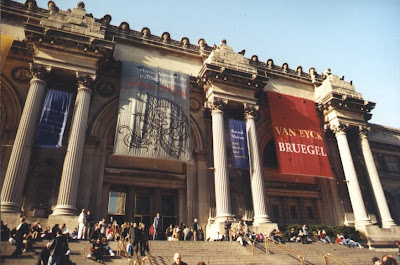
The Metropolitan Museum of Art is an art museum located on the eastern edge of Central Park, along what is known as Museum Mile in New York City, USA. It has a permanent collection containing more than two million works of art, divided into nineteen curatorial departments. The main building, often referred to simply as "the Met," is one of the world’s largest art galleries, and has a much smaller second location in Upper Manhattan, at "The Cloisters," which features medieval art.
Represented in the permanent collection are works of art from classical antiquity and Ancient Egypt, paintings and sculptures from nearly all the European masters, and an extensive collection of American and modern art. The Met also maintains extensive holdings of African, Asian, Oceanic, Byzantine and Islamic art. The museum is also home to encyclopedic collections of musical instruments, costumes and accessories, and antique weapons and armor from around the world. A number of notable interiors, ranging from 1st century Rome through modern American design, are permanently installed in the Met’s galleries.

The Metropolitan Museum of Art was founded in 1870 by a group of American citizens. The founders included businessmen and financiers as well as leading artists and thinkers of the day who wanted to open a museum to bring art and art education to the American people. It opened on February 20, 1872, and was originally located at 681 Fifth Avenue. John Taylor Johnston, a railroad executive whose personal art collection seeded the museum, served as its first President, and the publisher George Palmer Putnam was its founding Superintendent. The artist Eastman Johnson acted as Co-Founder of the museum. In 1873, occasioned by the Met’s purchase of the Cesnola Collection of Cypriot antiquities, the museum took up temporary residence at the Douglas Mansion on West 14th Street; after negotiations with the City of New York, the Met acquired land on the east side of Central Park, where it built its permanent home, a red-brick Gothic Revival stone "mausoleum" designed by American architects Calvert Vaux and Jacob Wrey Mould. The building was designated a National Historic Landmark in 1986.
As of 2007, the Met measures almost a quarter mile long and occupies more than two million square feet, more than 20 times the size of the original 1880 building.
Represented in the permanent collection are works of art from classical antiquity and Ancient Egypt, paintings and sculptures from nearly all the European masters, and an extensive collection of American and modern art. The Met also maintains extensive holdings of African, Asian, Oceanic, Byzantine and Islamic art. The museum is also home to encyclopedic collections of musical instruments, costumes and accessories, and antique weapons and armor from around the world. A number of notable interiors, ranging from 1st century Rome through modern American design, are permanently installed in the Met’s galleries.

The Metropolitan Museum of Art was founded in 1870 by a group of American citizens. The founders included businessmen and financiers as well as leading artists and thinkers of the day who wanted to open a museum to bring art and art education to the American people. It opened on February 20, 1872, and was originally located at 681 Fifth Avenue. John Taylor Johnston, a railroad executive whose personal art collection seeded the museum, served as its first President, and the publisher George Palmer Putnam was its founding Superintendent. The artist Eastman Johnson acted as Co-Founder of the museum. In 1873, occasioned by the Met’s purchase of the Cesnola Collection of Cypriot antiquities, the museum took up temporary residence at the Douglas Mansion on West 14th Street; after negotiations with the City of New York, the Met acquired land on the east side of Central Park, where it built its permanent home, a red-brick Gothic Revival stone "mausoleum" designed by American architects Calvert Vaux and Jacob Wrey Mould. The building was designated a National Historic Landmark in 1986.
As of 2007, the Met measures almost a quarter mile long and occupies more than two million square feet, more than 20 times the size of the original 1880 building.
No comments yet:
Post a Comment